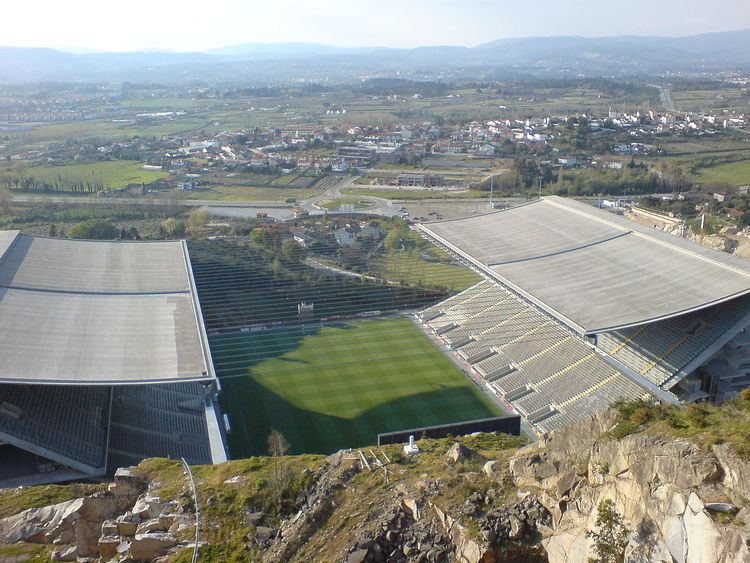Surface Grass Capacity 30,286 Opened 30 December 2003 | Built 2003 Construction started January 2001 | |
 | ||
Owner Câmara Municipal de Braga Field size 105 m × 68 m (344 ft × 223 ft) Similar Estádio do Bonfim, Estádio Municipal Eng Man, Estádio Marcolino de Castro, Estádio do Bessa, Estádio do Dragão | ||
The Municipal Stadium of Braga (Portuguese: Estádio Municipal de Braga) is a Portuguese football stadium in civil parish of Real, Dume e Semelhe in the municipality of Braga, in the district of the same name. Also known as A Pedreira (The Quarry), since it was carved from the face of Monte do Castro, it was built in 2003 as the home pitch for the Sporting Clube de Braga and a venue for the 2004 UEFA European championships.
Contents
History
The project to build a stadium was developed in 2000 by architect Eduardo Souto Moura. On 5 June, the program to build the new municipal stadium, promoted by the municipal council of Braga, for the European championships in 2004.
Between 2002 and 2003 the municipal stadium was built. The enormous rock moving process contributed heavily to the final €83.1 million cost, the fourth most expensive of the ten new stadia built for Euro 2004, after Estádio da Luz (capacity: 65,647) and Estádio José Alvalade (capacity: 50,049), both in Lisbon, and Estádio do Dragão (capacity: 50,399) in Porto. A football game between Sporting of Braga and Celta Vigo inaugurated the opening of the stadium on 30 December 2003.
The stadium became an UEFA-approved to host for the UEFA Europa League final, as well as participate in the elite competition for Europe's top clubs, the UEFA Champions League. During the UEFA European Championship it was the centre of various matches including: the 13th game, between Group C teams Bulgaria and Denmark (18 June 2004) and the 23rd match between Group D teams Netherlands and Latvia (22 June 2004). This match marked the last event during the UEFA championship in 2004, even as in October of the same year, the public work along the Avenida do Estádio was concluded.
On 27 January 2005, a dispatch was open by the president of the IPPAR to classify the stadium as national patrimony. In the same year Eduardo Souto Moura received the Secil Prize from the Portuguese President of Republic Jorge Sampaio, for his work on the municipal stadium. It was followed, six years later by the Pritzker Prize.
In 2006 the stadium won the Chicago Athenaeum International Architecture Award for the best new global design.
As the principal tenant, Sporting Clube de Braga paid monthly rent of €500 for the use of the stadium. In July 2007, S.C. Braga announced a three-year sponsorship deal with French insurance company AXA, which included a promotional change to the name of the municipal stadium by the club. Following this agreement, promoters and team officials began to refer to the municipal stadium of Braga as the Estádio AXA (AXA Stadium). However, the municipality (as landlord) clarified that the stadium had not been officially renamed, as this was a deal between its tenant and its partner.
On 23 October 2009, the process to classify the stadium ran out, under terms of article 78 (decree 309/2009), but was prorogued on 23 October.
A Financial Times article on Britain's stadia referred to the municipal stadium as one of the four examples of "beautiful grounds", noting that: "There has been nothing in this country to match the architectural delight of Eduardo Souto de Moura’s stadium for Braga in Portugal, a breathtaking arena carved into the side of a rock face on the site of a former quarry".
Architecture
The stadium is situated in an isolated, urban area on the north flank of Monte do Castro, in the sporting park of Dume.
The stadium was carved from the Monte do Castro quarry that overlooked Braga: stands were constructed on either side of the pitch, while one of the goals was carved from the rock walls of the quarry. The opposite goal is dominated by the city sprawl. Each stand is covered with a canopy-style roof and connected by a dozen of steel strings, a design inspired by ancient South American Incan bridges.
Movement between stands is accomplished through a 5,000 square metres (0.0050 km2) plaza under the pitch.
Events
The stadium hosted two Euro 2004 group stage matches, Bulgaria vs. Denmark and Netherlands vs. Latvia.
The following national team matches were held in the stadium.
